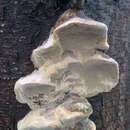en
names in breadcrumbs


Phellinus is a genus of fungi in the family Hymenochaetaceae. Many species cause white rot. Fruit bodies, which are found growing on wood, are resupinate, sessile, and perennial. The flesh is tough and woody or cork-like, and brown in color. Clamp connections are absent, and the skeletal hyphae are yellowish-brown.[1]
The name Phellinus means cork.[2]
The species Phellinus ellipsoideus (previously Fomitiporia ellipsoidea) produced the largest ever fungal fruit body.[3][4]
Phellinus species produce a number of natural chemicals which are of interest to science. These include the natural phenol hispidin,[5] bio-active styrylpyrones called phelligridins,[6] and bio-active isolates called phellinins.[7]
In Australia, Aborigines have used Phellinus fruit bodies medicinally. The smoke from burning fruit bodies was inhaled by those with sore throats. Scrapings from slightly charred fruit bodies were drunk with water to treat coughing, sore throats, "bad chests", fevers and diarrhoea. There is some uncertainty about which species of Phellinus were used.[8]
As of January 2015, Index Fungorum lists 154 species of Phellinus:[9]
Phellinus is a genus of fungi in the family Hymenochaetaceae. Many species cause white rot. Fruit bodies, which are found growing on wood, are resupinate, sessile, and perennial. The flesh is tough and woody or cork-like, and brown in color. Clamp connections are absent, and the skeletal hyphae are yellowish-brown.
The name Phellinus means cork.
The species Phellinus ellipsoideus (previously Fomitiporia ellipsoidea) produced the largest ever fungal fruit body.
 Phellinin A-B.png
Phellinin A-B.png Phellinus species produce a number of natural chemicals which are of interest to science. These include the natural phenol hispidin, bio-active styrylpyrones called phelligridins, and bio-active isolates called phellinins.